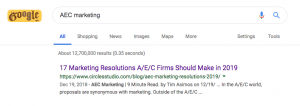
Another holiday season brings with it the promise of a new year; new opportunities; new marketing endeavors; and, for many small business owners, a new blog.
We all know by now that companies need blogs to thrive in today’s marketing environment; that the production of original content is crucial for obtaining online visibility, and that a blog is really the best avenue for doing so.
Still, not all companies have gotten on the blogging bandwagon; some are looking to finally start blogging in earnest, while others may need a fresh start after previous, failed attempts at effective blogging.
For any small business looking to launch a new blog in the near future, it’s obviously important to be strategic, disciplined, and thorough in your approach. What exactly do you need to ensure that your new business blog is a success? If you’ve got all seven items on our new blog checklist, then you’ve got a good foundation and every chance in the world of making your blog a winner.
Our new blog checklist includes:
- A clearly-defined set of goals. As we’ve discussed before, there are many potential goals for you to set with your content marketing, all of them legitimate. What matters is that you think them through and decide on clear, measurable objectives—whether it’s increased website traffic, brand visibility, conversions, or simply consumer trust.
- The definition of roles. Who’s going to be updating your blog? Who’s writing, who’s posting, and who’s responding to comments? Maybe it’s the business owner, maybe it’s an intern, maybe it’s someone else—but having a defined chain of command is important.
- A blog host and domain. There are pros and cons associated with having your blog hosted on your website versus having it as its own separate site; the former will offer some SEO clout for your website, and generally make navigation easier, while the latter provides you with an entirely separate online asset that can be useful for online reputation management and general visibility.
- In keeping with the previous point, though, your blog must be accessible. People should know how to get to it without any trouble; make a link to your blog clearly visible from your company website—preferably above the fold—and, if possible, from every other page of your site, as well.
- An attractive layout. Your blog also needs a good, clean, uncluttered look—consistent with the look and feel of your website, and easy to navigate and to search.
- Before you launch or publicize your blog, make sure to have at least three or four posts written and posted, so you’ve got a good foundation for the start of the blog.
- An editorial calendar. Finally, make sure you’ve planned when and how often your blog will be updated, and that you’ve got an editorial calendar set up, denoting your next couple week’s worth of posts (if not more).
Digital & Social Articles on Business 2 Community
(367)







